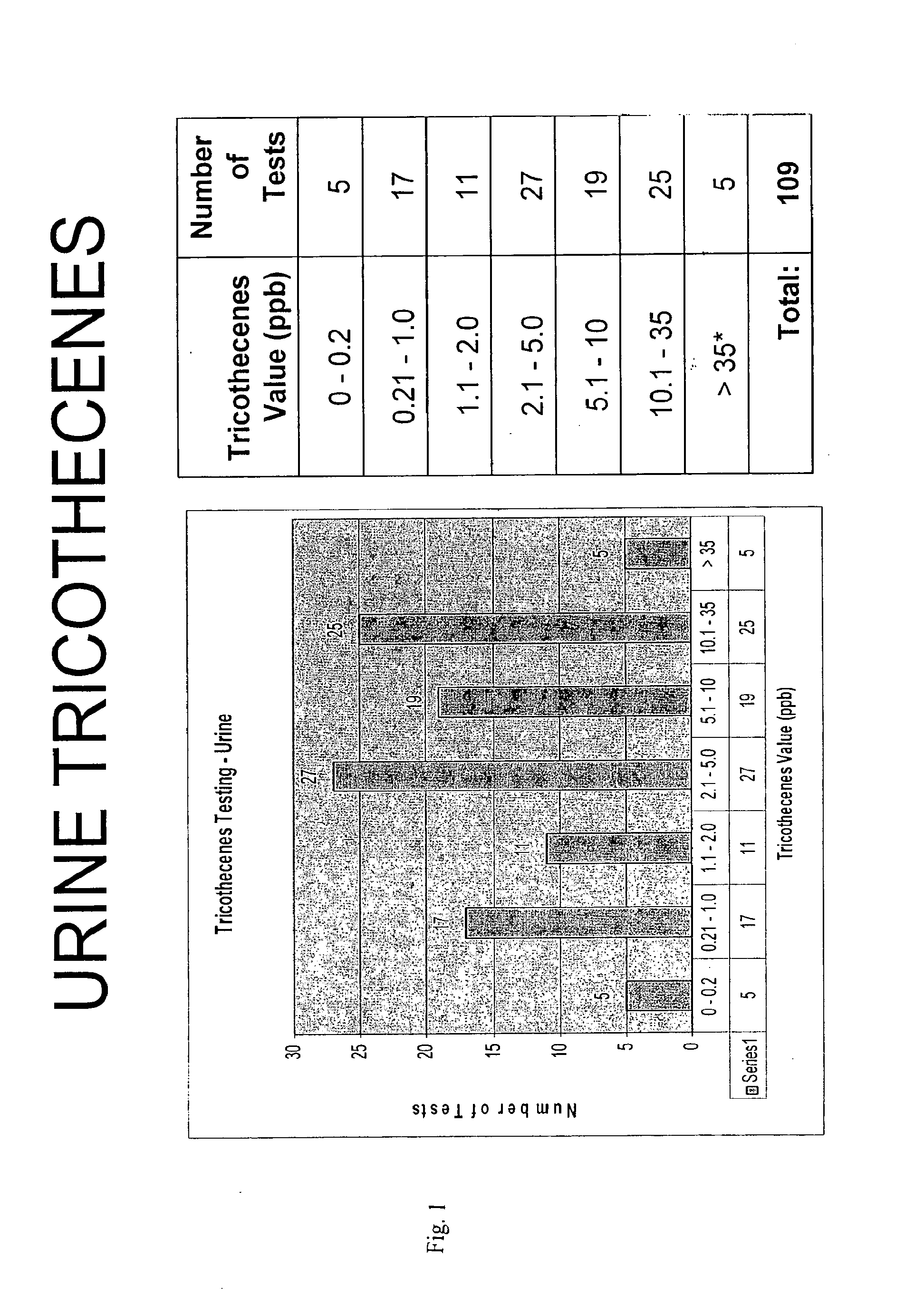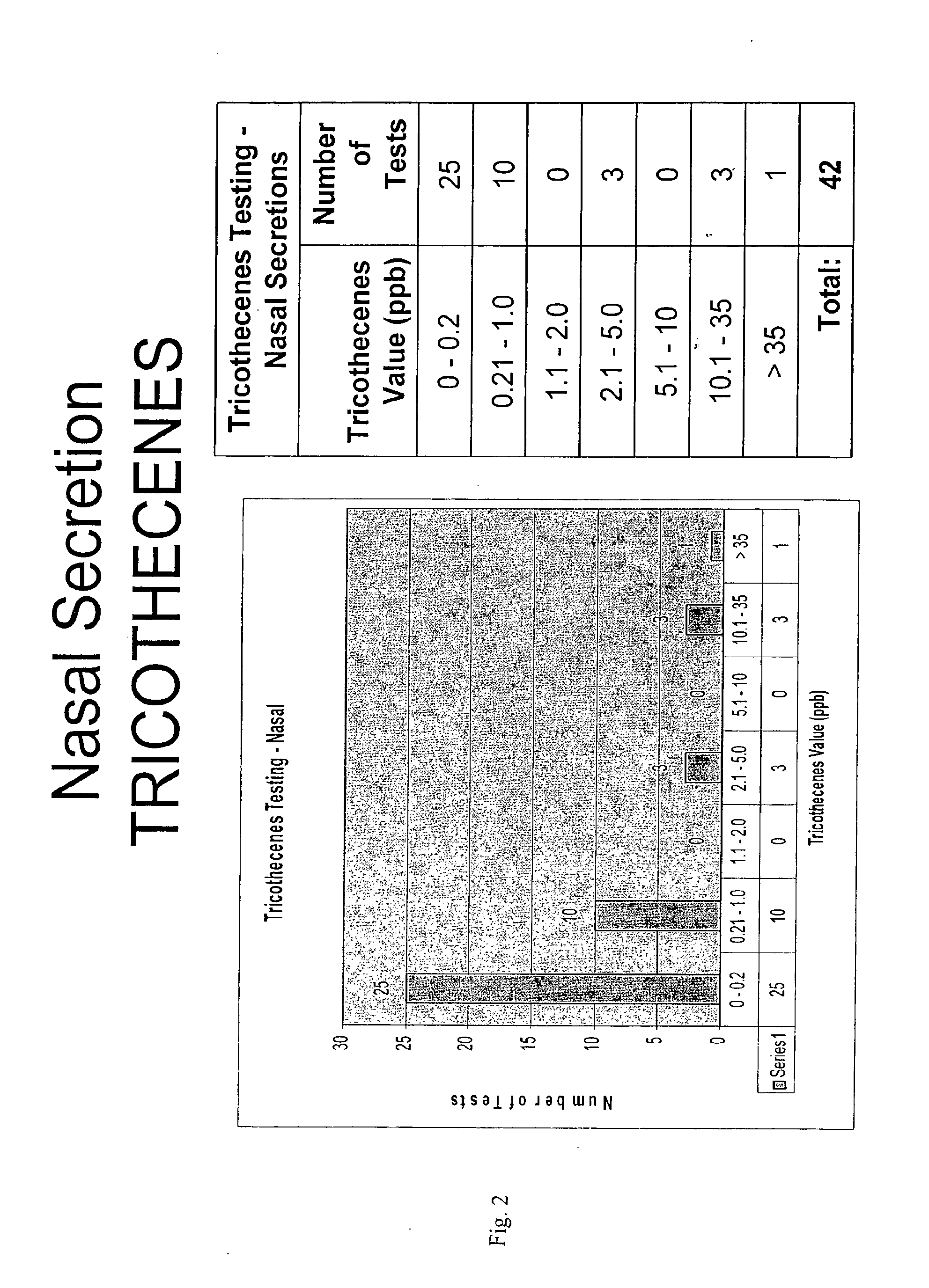Methods And Compositions For Detecting Fungi And Mycotoxins
a technology of mycotoxins and compositions, applied in the field of methods and compositions for detecting or identifying fungi or detecting or identifying mycotoxins, can solve the problems of affecting the health of patients, affecting the quality of life of patients, so as to achieve reliable, sensitive, rapid and reliable results
- Summary
- Abstract
- Description
- Claims
- Application Information
AI Technical Summary
Benefits of technology
Problems solved by technology
Method used
Image
Examples
example 1
Samples and Sample Preparation
[0061]Human urine was received in 5-10 ml quantities as first in the morning voided urines. Serums were received with the blood clot removed prior to receipt and a minimum of 1 ml of serum was frozen or used. Nasal secretions were obtained from hospital patients or out-patients. Fixed autopsy and surgical biopsy specimens were obtained from patients who had a history of exposure to mycotoxins or fungi. These samples were obtained from hospital pathology departments or coroners' offices. Tissue samples and body fluid samples were also obtained from patients who had no exposure to mycotoxins or fungi and were sampled as a negative control group. Tissue specimens were cut using procedures described in Examples 2 and 7.
[0062]All specimens were placed into two groups. Group 1 comprised samples from individuals with no reported symptoms or known fungi or mycotoxin exposure. These samples served as negative controls and n values differed in each group of speci...
example 2
Preparation of Tissues for Mycotoxin Extraction
[0065]Preparation of tissues for myctotoxin extraction from formalin fixed tissue and paraffin-embedded tissue from humans or animals was accomplished using the following procedure.
Specimens
[0066]Tissue was received as either tissue fixed in a 10% formalin solution or in a paraffin-embedded tissue block. Tissue can be stored indefinitely in either form. However, because of cross-linking of formalin and proteins which may give false negative readings for DNA, the tissue was not stored in formalin for greater than 6 months. A minimum of 25-35 mg of formalin-fixed tissue was required for mycotoxin extraction. A maximum of 3 grams of formalin-fixed tissue can be used.
Materials
[0067]Phosphate Buffered Saline (PBS; 0.9%), acid-washed silica beads (Cat # G1277; obtained from Sigma-Aldrich), collection tubes (2 ml) screw cap, methanol (reagent grade, Sigma), and microcentrifuge tubes (2 ml) were used.
Procedure
[0068]For silica beads, 0.3 g±0.01 ...
example 3
Preparation of Body Fluids for Mycotoxin Detection
[0070]Urine was received from a morning fresh first-voided specimen and stored at 1-6 degrees centrigrade in a glass container. A urine analysis was conducted using a dipstick to measure pH, specific gravity, glucose, nitrates, ketones, and blood. The urine was examined for sediment and was centrifuged at 2500 rpm for 5 minutes if sediment was present. The supernatant was saved in a glass container for mycotoxin testing (storing in plastic was avoided to avoid a decrease in the detection level of tricothecenes). The urine was then used as indicated in Example 4 for aflatoxin determination, Example 5 for ochratoxin determination, and Example 6 for tricothecene determination.
[0071]Nasal secretions and mucous samples as well as washes were observed for mucous presence. If mucous was present, a solution of MUCOSOL™ (Alpha Tec Systems, Inc. Vancouver, Wash.) was prepared and added in equal amounts of body fluid to MUCOSOL™ in the secretio...
PUM
 Login to View More
Login to View More Abstract
Description
Claims
Application Information
 Login to View More
Login to View More - R&D
- Intellectual Property
- Life Sciences
- Materials
- Tech Scout
- Unparalleled Data Quality
- Higher Quality Content
- 60% Fewer Hallucinations
Browse by: Latest US Patents, China's latest patents, Technical Efficacy Thesaurus, Application Domain, Technology Topic, Popular Technical Reports.
© 2025 PatSnap. All rights reserved.Legal|Privacy policy|Modern Slavery Act Transparency Statement|Sitemap|About US| Contact US: help@patsnap.com



